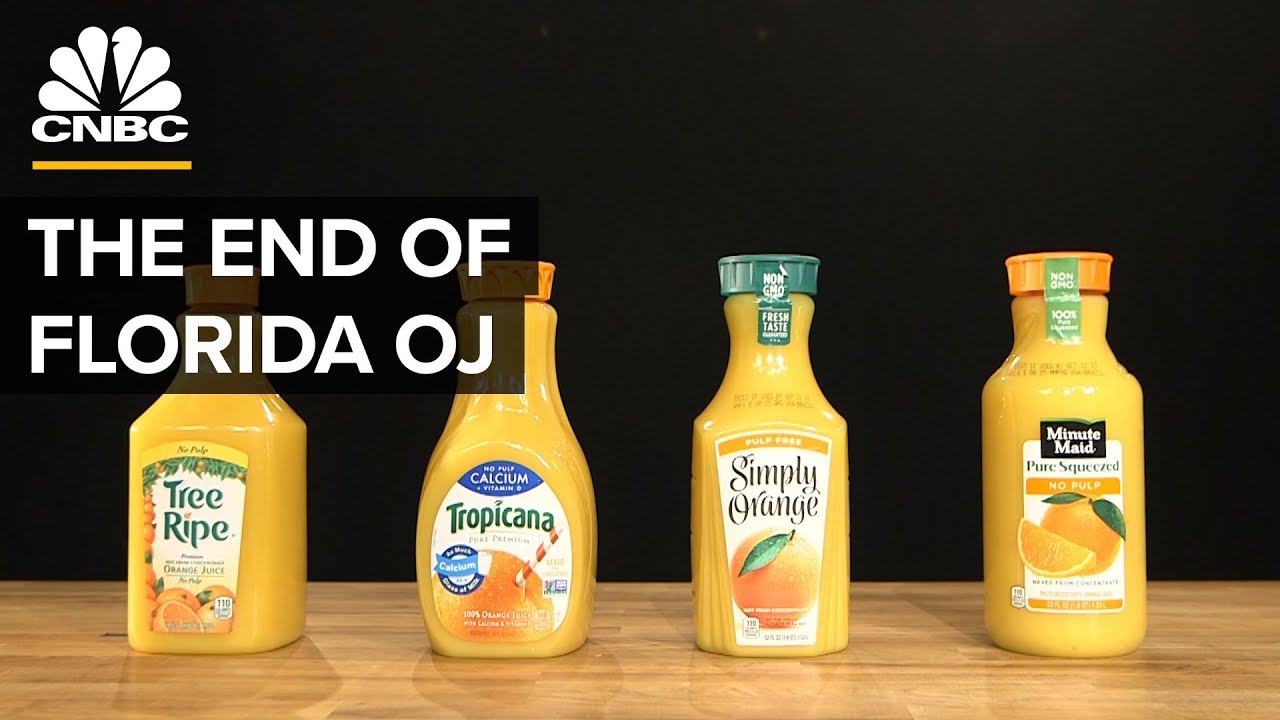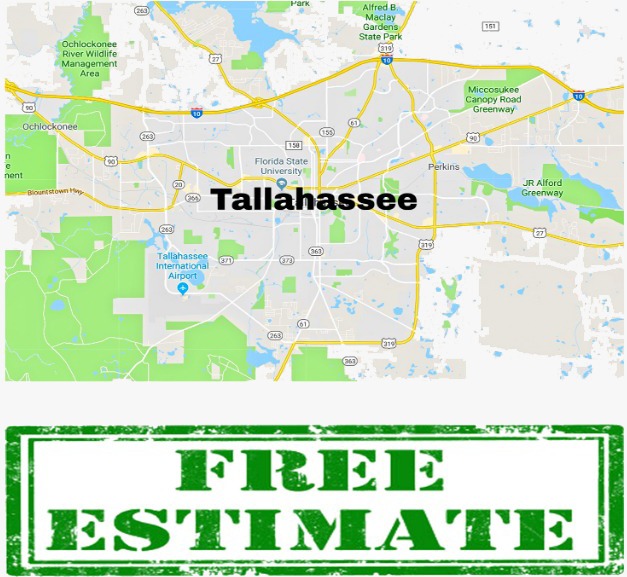Why Does Most US Orange Juice Come From Brazil, Not Florida?

In the United States, orange juice is synonymous with Florida.
During the 1960’s Florida was the largest producer of orange juice, but as of 2017, Brazil holds that title.
It may come as a surprise, then, to look at the fine print on a bottle of Tropicana and Simply Orange and discover that part of the product isn’t from the Sunshine State after all.
It’s from Brazil.
Hurricanes, frost and lack of land for orange groves is restricting the state’s citrus production.
Even though we have an orange on our license plates, we are growing less and less of the fruit.
Orange juice is big business in Brazil. After a series of frosts swept through Florida in the 1960s, devastating orange groves, Brazil met that deficit with its own supply, starting with frozen concentrate orange juice.
Then, in 2005, citrus greening disease, which had spread throughout the world from China, arrived in Miami.
It rendered oranges in affected groves inedible, resulting in a 55 percent decline in production over the next decade.
In response, Florida’s orange growers raised OJ prices by nearly $2 per gallon, causing bottlers to turn to cheaper Brazilian OJ.
The post Why Does Most US Orange Juice Come from Brazil, Not Florida? appeared first on 850 WFTL.
ANOTHER STORY
Acouple of weeks ago when I was having breakfast, I noticed that my “not from concentrate” orange juice came from Brazil. This was amazing on several levels. First, the idea that someone in Minnesota could be drinking fresh orange juice that came all the way from Brazil is astonishing! But the second thought was equally impactful. Why would my orange juice not come from America? After all, isn’t Florida famous as the king of OJ? I had read about a disease causing problems for Florida orange trees, and that overall, fewer people drink orange juice these days.
But still. This experience followed my reading of a story in the Wall Street Journal about how poultry farmers in the Southeast were importing their feed corn from Brazil, because it was less expensive than the corn grown in their own state. This story brought back memories from the early 1970s. Back then I was amazed at the new small car, built by Honda, being imported from Japan. It was a novelty then, but ten years later it wasn’t.
Are the new imported food examples just novelties, or the beginning of a trend? After all, one of the things that the United States is supposed to be good at is feeding itself, with a lot left over for export. For a long time now, we have conceded that we are no longer competitive in many areas of manufacturing, but we are still great at producing food. But even the notion that we can allow our manufacturing jobs to disappear is disturbing. Nothing can come close to mass production in generating wealth. Of course wealth can be shifted to financial engineers, but they don’t actually generate wealth for society, they just redistribute it.
In light of such things, I’ve been wondering lately about all the touted advantages for the American people of so-called universal “free trade.” I realize that the notion of free trade is commonly accepted as a globally beneficial good, and that questioning it puts one in the same category that heretics are usually relegated to. But here goes.
I was taught in school that free trade was inherently good, because it provided the most efficient method of producing material goods and services, taking advantage of each country’s comparative advantage. But, what if our modern global economy has erased any notion that a comparative advantage exists today? I contend that three major developments have rendered the idea of comparative advantage obsolete. These three developments are: logistics, communications, and computer-aided everything.
Let’s start with logistics. I can ship a forty-foot container with a 40,000-pound weight capacity from China to Minnesota for about $4,000. That includes the many handling fees and extra charges. So, any manufactured good can be shipped halfway around the world for less than ten cents a pound! A television might cost $3 to ship, while your new blender might cost a buck. Bulk commodities cost far less to ship, as do specialty items such as automobiles. You get the picture. Whether something is built next door or halfway around the world, the guy next door will have to meet the price of a product built a world away.
The second major development for global trade is the internet. The internet has obliterated another comparative-advantage attribute—ease of communication. It is now painless and simple to communicate with any factory or design center anywhere in the world. Drawings and videos can be exchanged, designs reviewed, and problems solved, in a matter of minutes. For those of us who are unable to communicate in multiple languages, really good translation programs exist, most of which are free.
The third obliterator of comparative advantage is computer-assisted everything. Whether you are machining a precision plastic mold or entering an invoice, chances are that a computer is really doing most of the difficult work. This assistance has virtually eliminated any kind of craftsmanship or skilled-labor content that in previous eras would have provided a comparative advantage. With computer-assisted design and control, a plastics molder in rural Asia can actually deliver precision plastic parts just as well as, if not better than, the old tool maker in Wisconsin who had great skill in manually machining plastic molds.
So, if there really are no significant comparative advantages left for most products and services, might there be other factors that could influence the competitiveness of US companies? The answer is that yes, there are. But unfortunately, they are negative factors.
The US has the third-highest corporate tax rate in the world, with only the United Arab Emirates and Puerto Rico having higher. This tax rate saddles US companies with a huge competitive disadvantage in relation to foreign competitors. In addition to their tax disadvantage, US companies are now facing an avalanche of new regulations pouring out of Washington and the states, especially California. With fifty states and the federal government issuing pages of new regulations every day, operating a business in the US has never been more demanding.
So, what can a company do that wants to compete in a global free trade market? In the US at least, the company could support candidates for office who would work to reduce taxes and regulations. However, these actions have been promised for decades by politicians of both parties, with not much result. This really leaves only one option open to businesses: Find a country that has much lower tax rates and regulations, combined with a lower wage cost. This trend has been accelerating over the last two decades, leading to almost nomadic companies that move their factories from the US to China, then to Thailand, to Vietnam, etc., seeking ever lower labor costs.
Where does this globalization of wages leave the average US worker? Not in a very good position. Those with no college education and little vocational preparation are typically relegated to low-wage service industry jobs. After FICA and health care costs, these workers really aren’t left with much net income to provide for themselves, much less a family. And many high-income manufacturing jobs for individuals with more marketable skills have long since departed for less expensive countries. The idea that this group of workers is somehow going to be retrained for tech jobs is mostly a pipe dream.
How can this problem be solved? The best start would be to reduce taxes and regulations, especially those imposed by the so-called Affordable Care Act. Beyond that, how might the US foster an environment that will provide the “average guy” a well-paying job? Perhaps, as has recently been suggested, a new tax regimen of sharply lowering or eliminating the corporate income tax on exports could go a long way toward improving the lot of the average worker in the US.
One thing that can’t be done is to continue to pretend that universal free trade benefits everyone at this point in history. With the virtual elimination of comparative advantage, we may look back on Brazilian orange juice as just the beginning of a new wave that takes an additional toll on our un- or underemployed fellow Americans.




Recent Comments